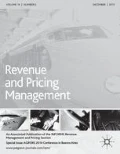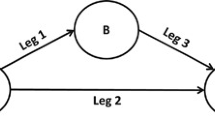Abstract
We consider the problem of generating the efficient frontier (or Pareto set) between two business goals in a pricing and revenue management context. We show that, under standard conditions on the demand function, the efficient frontier between revenue and profit will be continuous, bounded, downward-sloping and concave when pricing a single product. For the single-leg revenue management problem, we show that the efficient frontier between any two goals that are linear in load, such as revenue, load factor and operating contribution, can be efficiently generated using a weighted-sum (or scalarization) approach. We give some numerical examples of the weighted sum approach applied to the discrete-time single leg revenue management problem, as well as applied to an Expected Marginal Seat Revenue heuristic. We discuss possible extensions to a general choice model and to a full network.




Similar content being viewed by others
Notes
The terms ‘efficient frontier’, ‘Pareto frontier’ and ‘Pareto set’ are often used interchangeably in the literature.
It should be noted that the term ‘efficient frontier’ has been used in the revenue management literature to denote the undominated combinations of total expected demand and total expected revenue that could be achieved from different combinations of choice sets. This use of the term ‘efficient frontier’ – which is different from ours – was introduced by Talluri and van Ryzin (2004) and used in this sense in some other papers dealing with choice modeling such as Maglaras (2006).
Load factor is defined as the number of passengers carried on a flight departure (the load) divided by the capacity of the flight. It is a commonly used metric in the passenger airline industry.
References
Belobaba, P. (1989) Application of a probabilistic decision model to airline seat inventory control. Operations Research 37 (2): 183–197.
Belobaba, P. and Weatherford, L. (2007) Comparing decision rules that incorporate customer diversion in perishable asset revenue management situations. Decision Sciences 27 (2): 343–363.
Boyd, S. and Vandenberghe, L. (2004) Convex Optimization. Cambridge, UK: Cambridge University Press.
Britting, B. (2006) Profit-Based Pricing: Time to Stop Leaving Money on the Table. Tower Group Report V48:13C. Tower Group. Needham, MA.
Charnes, A. and Cooper, W.W. (1961) Management Models and Industrial Applications of Linear Programming, New York: Wiley.
Das, I. and Dennis, J.E. (1997) A closer look at drawbacks of minimizing weighted sums of objectives for Pareto set generation in multicriteria optimization problems. Structural Optimization 14 (1): 63–69.
Gallego, G., Li, L. and Ratliff, R. (2009) Choice-based EMSR methods for single-leg revenue management with demand dependencies. Journal of Revenue and Pricing Management 8 (2–3): 207–240.
Geoffrion, A.M. (1968) Proper efficiency and the theory of vector maximization. Journal of Mathematical Analysis and Applications 22 (3): 618–630.
Koski, J. (1988) Multicriteria truss optimization. In: W. Stadler (ed.) Multicriteria Optimization in Engineering and the Sciences. New York: Plenum Press, pp. 263–307.
Kumbhakar, S.C. and Knox Lovell, C.A. (2000) Stochastic Frontier Analysis. Cambridge, UK: Cambridge University Press.
Lariviere, M.A. (2006) A note on probability distributions with increasing generalized failure rates. Operations Research 54 (3): 602–604.
Lee, H.L. and Billington, C. (1995) The evolution of supply-chain-management models and practice at Hewlett-Packard. Interfaces 25 (9): 42–63.
Lee, S.M. (1972) Goal Programming for Decision Analysis. Philadelphia, PA: Auerback.
Lee, T.C. and Hersh, M. (1993) A model for dynamic airline seat inventory control with multiple seat bookings. Transportation Science 27 (3): 252–265.
Levin, Y., McGill, J. and Nediak, M. (2008) Risk in revenue management and dynamic pricing. Operations Research 56 (2): 326–343.
Luenberger, D. (1994) Microeconomic Theory. New York: McGraw-Hill.
Maglaras, C. (2006) Dynamic pricing strategies for multi-product revenue management problems. Manufacturing and Service Operations Management 8 (2): 136–148.
Markowitz, H. (1959) Portfolio Selection. New Haven, CT: Cowles Foundation, Yale University.
Mitra, D. and Wang, Q. (2005) Stochastic traffic engineering for demand uncertainty and risk-aware network revenue management. IEEE/ACM Transactions on Networking 13 (2): 221–238.
Phillips, R. (2005) Pricing and Revenue Optimization. Stanford, CA: Stanford University Press.
Smith, B.C., Leimkuhler, J.F. and Darrow, R.M. (1992) Yield management at American Airlines. Interfaces 22 (1): 8–31.
Talluri, K. and van Ryzin, G. (2004) Revenue management under a general discrete choice model of consumer behavior. Management Science 50 (1): 15–33.
Talluri, K. and van Ryzin, G. (2005) The Theory and Practice of Revenue Management. New York, NY: Springer.
Thomas, L.C., Oliver, R.W. and Hand, D.J. (2005) A survey of the issues in consumer credit modelling research. Journal of the Operations Research Society 56 (9): 1006–1015.
Tóth, S.F., McDill, M.E. and Rebain, S. (2006) Finding the efficient frontier of a bi-criteria, spatially explicit, harvest scheduling problem. Forest Science 52 (1): 93–113.
Walczak, D. (2010) Balancing expected profit contribution and resource utilization. Presented at 2010 INFORMS Revenue Management and Pricing Conference; 18 June, Ithaca, NY.
Zadeh, L.A. (1963) Optimality and non-scalar-valued performance criteria. IEEE Transactions on Automatic Control, AC 8 (1): 59–60.
Ziya, S., Aydan, H. and Foley, R.D. (2004) Relationships among three assumptions in revenue management. Operations Research 52 (5): 804–809.
Acknowledgements
I am grateful to Robin Raffard of Nomis Solutions for his very detailed and useful comments on an earlier version of this article. I am also grateful to two anonymous reviewers for their very useful comments and suggestions.
Author information
Authors and Affiliations
Corresponding author
Rights and permissions
About this article
Cite this article
Phillips, R. Efficient frontiers in revenue management. J Revenue Pricing Manag 11, 371–385 (2012). https://doi.org/10.1057/rpm.2011.26
Received:
Revised:
Published:
Issue Date:
DOI: https://doi.org/10.1057/rpm.2011.26




